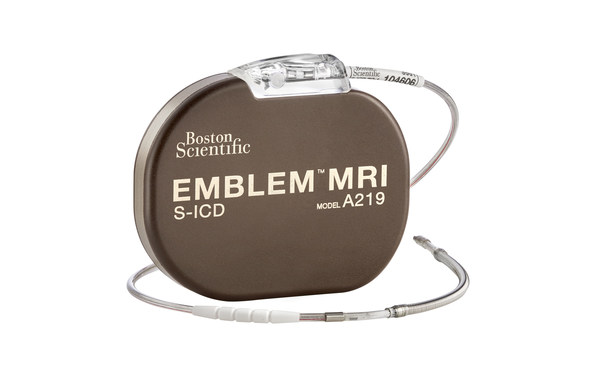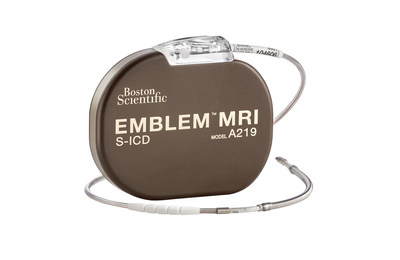MARLBOROUGH, Mass., May 8, 2020 /PRNewswire/ -- Boston Scientific (NYSE: BSX) today announced the final results from the UNTOUCHED study of the EMBLEM™ Subcutaneous Implantable Defibrillator (S-ICD) System presented at HRS 2020 SCIENCE, an online series from the Heart Rhythm Society.
The global, prospective, non-randomized UNTOUCHED study evaluated the safety and efficacy of the EMBLEM S-ICD System – the only approved implantable defibrillator without wires touching the heart – for primary prevention of sudden cardiac death specifically in patients with a left ventricular ejection fraction (LVEF) ≤35%, the most common population to be indicated for ICD therapy.1,2 Data demonstrated S-ICD therapy had an inappropriate shock-free rate of 95.9% at 18-months post-procedure, meeting the primary endpoint with a rate comparable to or lower than those seen in previous S-ICD and transvenous implantable cardioverter-defibrillator (TV-ICD) studies.
"This study conclusively shows high efficacy and safety of the EMBLEM S-ICD and the current generation EMBLEM MRI S-ICD with contemporary programming, despite the patients being some of the sickest studied to date, with much lower LVEF, more hypertension and diabetes," said Michael R. Gold, M.D., Ph.D, principal investigator and Michael E. Assey professor of medicine at The Medical University of South Carolina, Charleston. "Additionally, the rate of inappropriate shock was lower than that of many studies of TV-ICDs with contemporary programming designed to minimize this rate, validating use of the S-ICD as a first line therapy for the majority of patients in need of a device to manage risk of sudden cardiac death in the absence of pacing indications."
The endpoint analysis included data from 1,111 patients with a low LVEF, the majority of whom (53.8%) had ischemic heart disease and 87.6% with heart failure. Study authors reviewed the incidence of inappropriate shocks in these patients after 18 months to determine if it was higher than in a historical control group of patients who had a similarly programmed TV-ICD. Data also demonstrated a 97.6% inappropriate shock-free rate at one year for patients who had the SMART Pass sensing filter – an advanced feature that filters out certain signals that are the primary reason for inappropriate shocks – enabled on the newest generation EMBLEM MRI™ S-ICD System devices.
Also presented as a late-breaking clinical trial at the virtual meeting were results from the investigator-sponsored PRAETORIAN trial. Investigators of the prospective, randomized, head-to-head clinical trial confirmed that the S-ICD can be the preferred therapy choice for the majority of ICD-indicated patients without a need for pacing as it offers comparable performance while avoiding lead-related complications and serious infections associated with TV-ICDs.
"The EMBLEM S-ICD System has been implanted in more than 75,000 patients worldwide, providing a safe and effective therapy while avoiding many of the issues associated with TV-ICD leads," said Kenneth Stein, M.D., senior vice president and chief medical officer, Global Health Policy and Rhythm Management, Boston Scientific. "The UNTOUCHED and PRAETORIAN study data add to the body of evidence showing the benefits of the S-ICD System and further emphasize this device should be considered a first-line therapy for a broad group of ICD-indicated patients without a need for cardiac pacing."
For more information on the EMBLEM S-ICD System visit www.sicdsystem.com.
About Boston Scientific
Boston Scientific transforms lives through innovative medical solutions that improve the health of patients around the world. As a global medical technology leader for 40 years, we advance science for life by providing a broad range of high performance solutions that address unmet patient needs and reduce the cost of healthcare. For more information, visit www.bostonscientific.com and connect on Twitter and Facebook.
Cautionary Statement Regarding Forward-Looking Statements
This press release contains forward-looking statements within the meaning of Section 27A of the Securities Act of 1933 and Section 21E of the Securities Exchange Act of 1934. Forward-looking statements may be identified by words like "anticipate," "expect," "project," "believe," "plan," "estimate," "intend" and similar words. These forward-looking statements are based on our beliefs, assumptions and estimates using information available to us at the time and are not intended to be guarantees of future events or performance. These forward-looking statements include, among other things, statements regarding our business plans, clinical trials and product performance and impact. If our underlying assumptions turn out to be incorrect, or if certain risks or uncertainties materialize, actual results could vary materially from the expectations and projections expressed or implied by our forward-looking statements. These factors, in some cases, have affected and in the future (together with other factors) could affect our ability to implement our business strategy and may cause actual results to differ materially from those contemplated by the statements expressed in this press release. As a result, readers are cautioned not to place undue reliance on any of our forward-looking statements.
Factors that may cause such differences include, among other things: future economic, competitive, reimbursement and regulatory conditions; new product introductions; demographic trends; intellectual property; litigation; financial market conditions; and future business decisions made by us and our competitors. All of these factors are difficult or impossible to predict accurately and many of them are beyond our control. For a further list and description of these and other important risks and uncertainties that may affect our future operations, see Part I, Item 1A – Risk Factors in our most recent Annual Report on Form 10-K filed with the Securities and Exchange Commission, which we may update in Part II, Item 1A – Risk Factors in Quarterly Reports on Form 10-Q we have filed or will file hereafter. We disclaim any intention or obligation to publicly update or revise any forward-looking statements to reflect any change in our expectations or in events, conditions or circumstances on which those expectations may be based, or that may affect the likelihood that actual results will differ from those contained in the forward-looking statements. This cautionary statement is applicable to all forward-looking statements contained in this document.
CONTACTS:
Laura Aumann
Media Relations
(651) 582-4251 (office)
Laura.Aumann@bsci.com
Susie Lisa, CFA
Investor Relations
(508) 683-5565 (office)
BSXInvestorRelations@bsci.com
1 Friedman, DJ, Parzynski, CS, Varosy, PD, et al., Trends and In-Hospital Outcomes Associated With Adoption of the Subcutaneous Implantable Cardioverter Defibrillator in the United States. JAMA Cardiol, 2016. 1(8): p. 900-911.
2 Haugaa, KH, Tilz, R, Boveda, S, et al., Implantable cardioverter defibrillator use for primary prevention in ischaemic and non-ischaemic heart disease-indications in the post-DANISH trial era: results of the European Heart Rhythm Association survey. Europace, 2017. 19(4): p. 660-664.
SOURCE Boston Scientific Corporation


